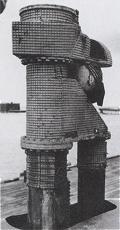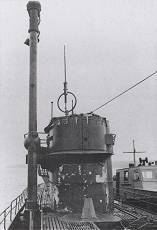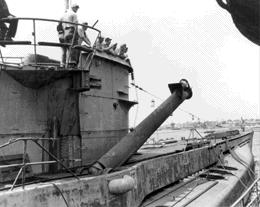

|
Snorkel
The development of the snorkel played a vital role in the history of the Battle of the Atlantic. As allied radar grew more potent, U-boats were forced to submerge and travel underwater to escape detection from allied radar. When submerged, a U-boat ran on electric engines and its powerful diesel engines were switched off as they were air-breathing and useless underwater. When running on electric engines, U-boats had very limited range and speed, and it needed to surface to run its diesels in order to recharge its batteries.
 |
 |
The snorkel was a device which allowed U-boats to run on diesel engines even when underwater. This was simply a pipe with a valve on one end, which extended above sea level while the boat was submerged. The tube consisted of an intake and exhaust pipe, where outside air was drawn into the U-boat, and exhaust gases expelled from the exhaust pipe. The shutoff valve prevented sea water from entering the intake if the mouth of the tube dipped below the surface.
Being able to run its diesels underwater was a tactical advantage for the Germans. Not only were they more powerful, faster, and longer range, but more importantly, they eluded allied radar. This allowed U-boats crossing the Bay of Biscay to travel underwater with relative safety from allied aircraft.
Despite its advantages, snorkels were not entirely faultless and had to be used with close supervision. The intake pipe did not lead directly to the diesel engines. This was to prevent unnecessary stoppages as it was common for the intake valve to open and shut as the ocean waves swept over the snorkel head, periodically submerging it. Instead, the intake pipe led to the inside of the boat, providing breathing air for the crew as well as the engines. The engines would draw air from the interior of the boat as usual, where the entire volume of the boat itself acted as an air buffer. In the event that the valve was suddenly closed, the diesels could run on for a short time, but this cannot be sustained for long. If the air supply was lost, the diesels had to be immediately disengaged to prevent the entire internal air from being extracted. Obviously, this would have catastrophic consequences for the crew. Thus, during the initial installations, the air supply was constantly monitored in order to stop the diesels whenever the valve closed, but this was later automated.
Another problem with running the diesels submerged was in the engine noise. As diesel engines were much noisier than their electrical counterpart, this meant that the U-boat’s hydrophones could not be used. The U-boat still had to rely on the limited view provided by the periscope, but to add to the problem, the periscope could not be used at speeds of over six knots. This was due to excessive vibrations on the periscope due to the forward motion of the boat. The wake and diesel exhaust fumes emitted at the snorkel head also adversely affected vision from the periscope. Later, the position of the snorkel head was relocated to the rear of the boat, so as not to interfere with the periscope. Finally, allied radar was still sensitive enough to be able to detect an object as small as a snorkel head. Although this was much more difficult compared to a surfaced U-boat, allied reports indicated that a surfaced U-boat could be detected up to a distance of 10km, whereas a snorkel head could be detected at only about 5km. Later, snorkel heads were coated with radar absorbing materials known as Tarnmatte. It was claimed that this reduced radar signature by up to 90 percent, although there were no definitive tests.
Snorkel Types
In general, snorkel designs comprised of two basic types. The earlier types were hinged snorkels, with the base set into an axle while the tube was raised and lowered like an arm. Once extended, it was locked into position by a large clamp. When in the lowered position, it lay flat in a long shallow well on the upper deck. The hinged snorkel was operated by hydraulics, for which there was no manual control if the hydraulics failed.
The second type is the telescopic snorkel. As its name implies, it was extended and retracted vertically, much like a periscope. For this, some U-boats had their auxiliary periscope removed and replaced by a snorkel instead, housed in the same periscope tube. This type of snorkel could be operated by hydraulics or manually by hand.
Originally German designers experimented with the idea of dispersing exhaust gases through underwater vents, so as to prevent smoke buildup which could be spotted visually. This idea was later dropped as the visibility of exhaust gases was considered too minute to justify serious development. As such, exhaust gases were simply expelled from small vents at the top of the snorkel head.
Two types of valves were used. The first was a ball float and later in 1945, it was replaced with a ring float. Both functioned in a similar concept. When above sea water, gravity would pull the float down, opening the valve above. When submerged, the positive buoyancy of the float pressed against the valve above, shutting it. When the snorkel was in its stowed position, the valves would open automatically so as to flood the tube.

|
| American sailors examine the snorkel of a surrendered U-boat, May 1945. |



